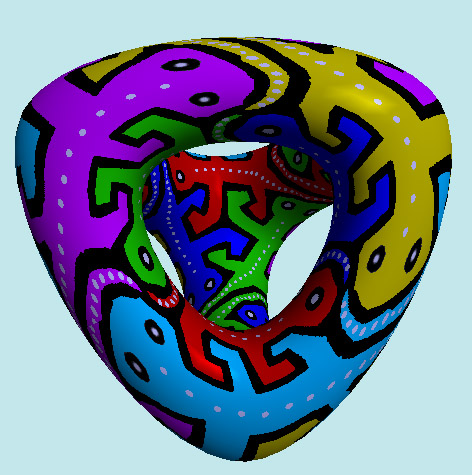
|
CS 39---:
SYMMETRY & TOPOLOGY
General Home Page and Index -- Fall 2020 >> CANCELLED
This Seminar is being postponed to a future semester where we can meet again in person.
|
Catalog Entry and Schedule
CS 39R: SYMMETRY & TOPOLOGY
- FULL COURSE TITLE: Symmetry and Topology
- COURSE NUMBER: CS 39-00?
- COURSE CONTROL NUMBER: ?????
- UNIT VALUE: 2 units P/F
- SEMESTER: Fall 2020
- CLASS TIME: Thursday: 2:10pm - 4:00pm; --
LOCATION: 606 Soda Hall
- INSTRUCTOR: Carlo H. Séquin
- OFFICE HOURS: see my homepage; -- LOCATION: 639
Soda Hall
PREREQUISITES:
- Students should have an interest in geometry and its many
applications in art, architecture, engineering, and most
domains of design.
They should enjoy some abstract mathematical thinking,
and should not be adverse to using precise formulations to
clarify some "fuzzy" concepts.
CONDITIONS FOR PASSING THIS COURSE:
- Good class attendance (not missing more than 1 or 2
classes).
- No student can join the class after the 2nd week.
- If you are on a waiting list and hope to join later, came
to and participate in all classes from the beginning.
- Active participation in class discussions.
- Making an honest effort on all homework problems.
- Giving an oral class project presentation.
- Writing a brief report on your class project.
Course Description
Symmetry plays an important role in art, fashion, architecture,
engineering, computer modeling, biology,
and in all the sciences in general; as well as in music, poetry,
and psychology.
We will explore its use in several of these domains.
We will enumerate all possible types of symmetry and establish a
rigorous understanding of them:
We will start with simple mirror images, proceed with the
rotational symmetries of hub caps, and
continue through wallpaper patterns and the 3D symmetries of
household objects, as well as mathematical knots,
to the symmetries of the Platonic solids and of regular polyhedra
in the 4th dimension.
Topology focuses on the connectivity of objects or of abstract
constructions;
it is important in the design and analysis of complicated shapes.
It also allows us to extend the notion of symmetry to the
interconnectivity of networks
and to "regular maps" on surfaces of arbitrary genus (smooth
donuts with one or more holes).
We will get familiar with all surfaces of low genus, including
Moebius bands, cross-caps, and Klein bottles.
The goal of this course is to give the participants a good enough
understanding of the basic principles
of symmetry and topology, so they can put this understanding to
good use in their future studies.
This course, even though offered by the CS Division, will not rely
on any computer programming,
but will ask participants to make sketches and to construct models
from paper, clay, or pipe-cleaners.
Inspirational Books:
"The Symmetries of Things" by John H. Conway, Heidi Burgiel
and Chaim Goodman-Strauss, (A.K.Peters, Wellesley, MA, 2008)
"Symmetry" by Hermann Weyl, (Princeton University Press, NJ,
1952, new issue: Jan 1, 1983)
"Tilings and Patterns" by B. Gruenbaum and G. C. Shephard,
(W. H. Freeman and Co., New York, 1987)
"Shapes, Space, and Symmetry" by Alan Holden, (Dover,
Columbia University Press, 1971)
"Symmetry -- A Unifying Concept" by Istvan & Magdolna
Hargittai, (Shelter Publications, Bolinas, CA, 1994)
"The Knot Book" by Colin C. Adams, (W. H. Freeman and Co.,
New York, 1994)
"Orderly Tangles" by Alan Holden, (Columbia University
Press, 1983)
About the Instructor:
Carlo H. Séquin has been a
professor in the EECS Computer Science Division since 1977.
He has taught courses concerning the design of integrated
circuits, micro processors, and campus buildings.
He has also taught courses on geometric modeling with hands-on
assignments in the design and fabrication
of mechanical puzzles, artistic maquettes, and mathematical
visualization models.
Outside of the class room he has made use of symmetry and topology
in the layout of solid-state image sensors at Bell Labs,
in the design of the first RISC (reduced instruction set computer)
chips with Professor Dave Patterson (CS),
in the conception and construction of Soda Hall, the current home
of the CS Division,
and in the generation of various large-scale geometrical
sculptures with artist Brent Collins from Gower, MO.
Last update of this page: 2020/02/22
Page Editor: Carlo H. Séquin